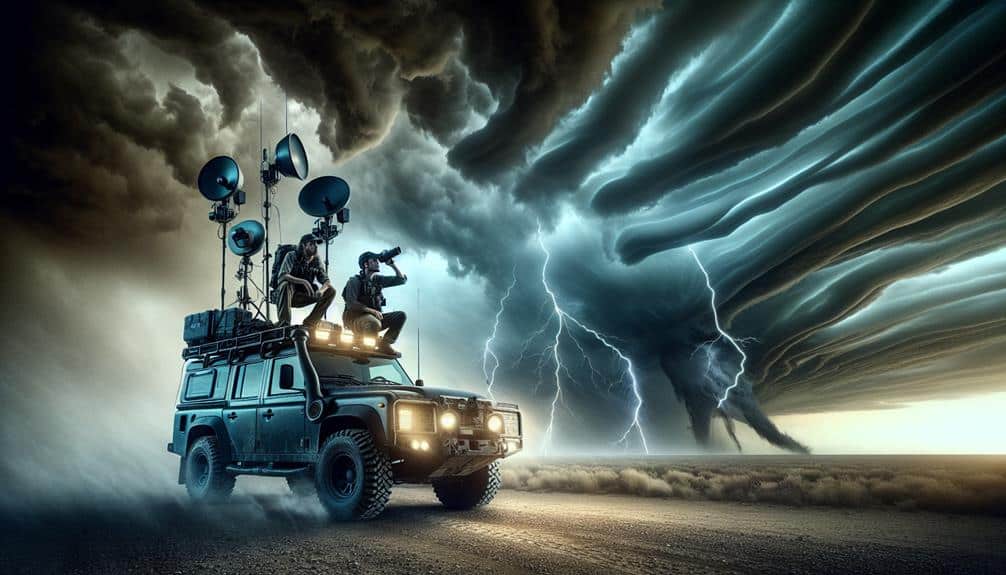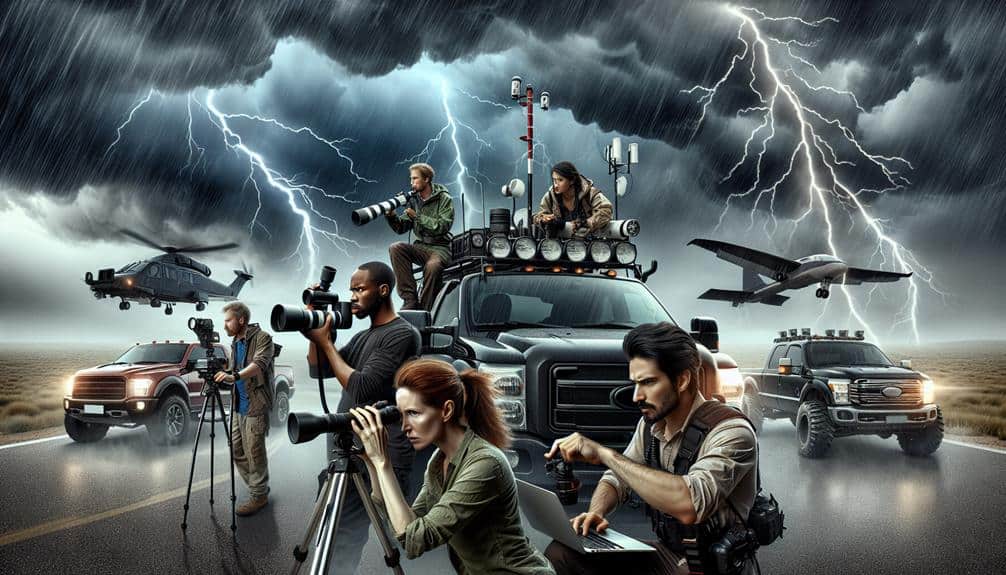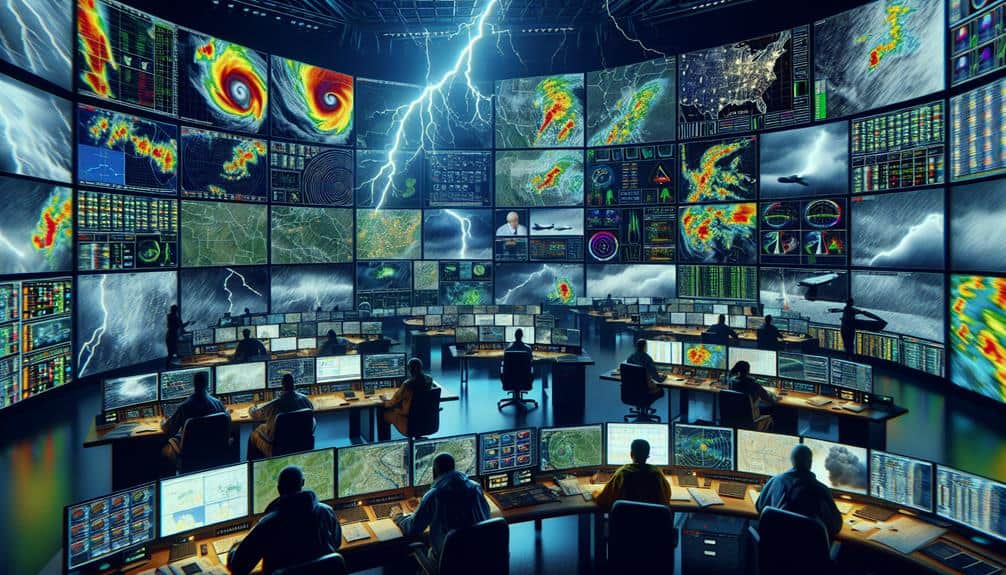We must prioritize our safety while storm chasing by adhering to key guidelines. First, join a reliable storm spotting network; they provide real-time, cross-verified data essential for accurate decision-making. Utilize robust emergency communication protocols, including backup channels and designated meeting points. Equip ourselves with reliable weather instruments and communication devices like GPS systems and satellite phones. Regularly share real-time updates via social media and dedicated storm chasing apps for collective situational awareness. Adhere to safety procedures, ensuring vehicle readiness and emergency plans. Embrace ethical practices by avoiding sensationalism and respecting local laws. Let's explore further to enhance our safety strategies.
Key Points
- Equip vehicles with GPS devices, first aid kits, and fire extinguishers for enhanced safety during storm chasing.
- Follow a detailed emergency response plan including backup communication channels and designated meeting points.
- Use reliable weather instruments and communication devices for accurate real-time data and broader communication capabilities.
- Prioritize public safety and respect private property, ensuring activities don't hinder emergency responses.
Understanding Storm Spotting Networks
To effectively participate in storm chasing, we must understand the important role that storm spotting networks play in gathering real-time data and enhancing safety. These networks, comprised of trained volunteers and meteorologists, are essential for providing accurate, timely information about storm conditions. Network reliability is key, as it ensures that the data collected is both accurate and actionable, which directly impacts our safety during storm chasing endeavors.
Community involvement is a cornerstone of these networks. Local volunteers, often with specialized training, contribute valuable observations that supplement radar data, offering a ground-level perspective on storm developments. This grassroots participation not only strengthens the data quality but also fosters a culture of collective responsibility and vigilance.
Training is another important aspect. By participating in organized training programs, we can become proficient in identifying storm patterns, understanding weather phenomena, and using communication tools effectively. These skills are essential for maintaining safety and making informed decisions in high-stress situations.
Choosing the Right Network
Selecting the best storm spotting network hinges on evaluating its data precision, volunteer training thoroughness, and real-time communication capabilities.
We need a network that offers thorough network coverage and network reliability to guarantee that we've the most up-to-date and accurate information when we're out in the field. Accurate data is crucial for making split-second decisions that could mean the difference between safety and danger.
When appraising potential networks, we should pay attention to the following criteria:
- Data Precision: Reliable networks provide real-time, accurate data that can be cross-verified with other trusted sources.
- Volunteer Training: A network's effectiveness is amplified by well-trained volunteers who can accurately report observations and utilize technology efficiently.
Communication Protocols
For storm chasing, we must set up robust communication protocols, prioritizing emergency contact plans and real-time updates. Data shows that having predefined emergency contacts can reduce response times by up to 40%.
Additionally, leveraging real-time updates guarantees we stay informed about rapidly changing weather conditions, enhancing our safety.
Emergency Contact Plans
Effective storm chasing demands that we establish strong emergency contact plans to guarantee seamless communication in crisis scenarios. Our safety hinges on how well we've prepped these protocols.
First, we need to compile detailed contact information for every team member and key external contacts, such as local emergency services and meteorological experts. This list should be easily accessible, both digitally and in printed form.
Moreover, we must establish clear emergency protocols to follow if communication lines break down. These procedures ensure that everyone knows their role and the steps to take when things go south.
Here's what we should focus on:
- Immediate Response Coordination: Make sure everyone knows the immediate steps to take if someone gets injured or lost.
- Designated Meeting Points: Predefine safe locations to regroup if separated.
Real-Time Updates
Our team's ability to relay real-time updates hinges on robust communication protocols that guarantee accurate and timely information flow. We prioritize setting up redundant systems that include live streaming and social media outreach to secure no data is lost or delayed.
By employing high-bandwidth mobile hotspots and satellite communications, we maintain connectivity even in remote areas. We've integrated advanced GPS tracking and automated alert systems into our workflow. These tools provide real-time location data and weather conditions, which we broadcast through live streaming platforms. This approach not only enhances our situational awareness but also allows us to share critical updates instantly with our audience.
Our social media outreach strategy involves real-time posts and interactive updates. We've developed a schedule and protocol for disseminating information across multiple platforms, making sure we reach diverse audiences. Analytics from social media interactions help us adjust our communication tactics on the fly, securing maximum engagement and information dissemination.
Equipment and Technology
We rely on precise weather instruments to monitor storm conditions and guarantee our safety.
High-quality communication devices are essential for maintaining contact with team members and receiving real-time updates.
Reliable Weather Instruments
When storm chasing, it's important to use reliable weather instruments like anemometers, barometers, and GPS systems to gather accurate data and guarantee safety. These tools are essential for precise weather monitoring and forecasting, enabling us to make informed decisions on the field.
Anemometers measure wind speed, helping us understand storm intensity, while barometers track atmospheric pressure changes, which are crucial for predicting storm development. GPS systems ensure we always know our exact location, aiding in both navigation and data correlation.
Relying on accurate instruments isn't just about collecting data; it's a key component of our safety precautions and preparation. Ensuring our equipment is calibrated and functioning at its best can mean the difference between staying safe and encountering unexpected dangers.
- Feeling the rush of wind: Anemometers let's gauge wind speeds, preparing us for powerful gusts.
- Reading atmospheric pressure: Barometers reveal vital data on storm formation, letting us anticipate changes.
Communication Devices
Effective communication devices, such as two-way radios and satellite phones, are essential for maintaining contact and guaranteeing team coordination during storm chasing missions. When we're out in the field, walkie talkies provide immediate, reliable communication over short distances, making certain that everyone stays informed about changing weather conditions and potential hazards. They operate independently of cellular networks, which can become unreliable during severe weather events, making them indispensable for real-time updates.
In contrast, satellite phones offer a broader range of communication, especially in remote areas where cell coverage is non-existent. These devices utilize satellites orbiting the Earth to transmit signals, allowing us to connect with emergency services, other team members, or meteorological experts regardless of our location. According to data from NOAA, areas affected by severe storms often experience significant infrastructure damage, underscoring the importance of having satellite phones as a backup communication tool.
We need to guarantee our communication devices are fully charged and tested before heading out. Using a combination of walkie talkies and satellite phones enhances our operational efficiency and safety, giving us the freedom to focus on capturing critical data without worrying about losing contact.
Real-Time Data Sharing
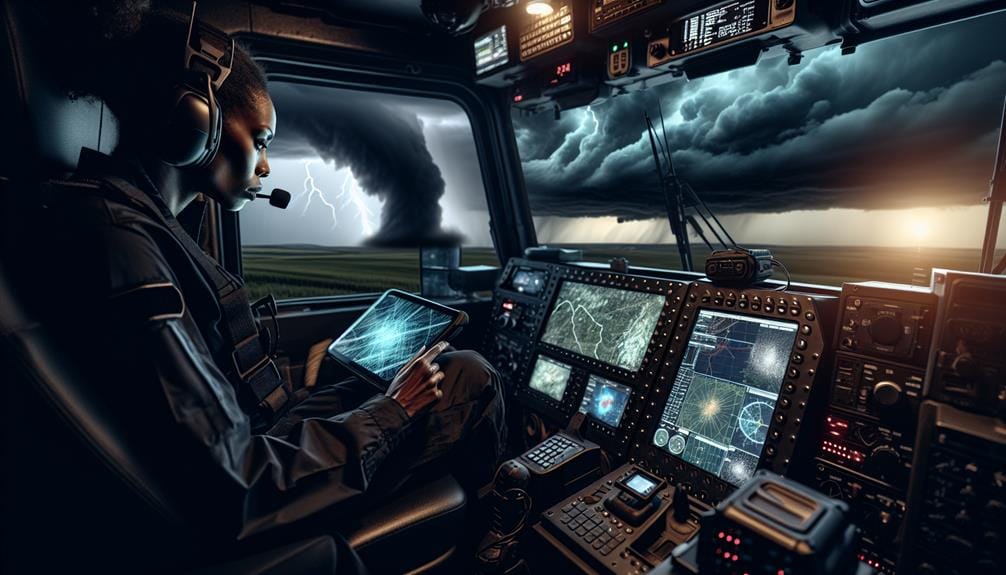
Leveraging real-time data sharing is crucial for storm chasers to make informed decisions and enhance safety during severe weather events. By tapping into the power of social media and fostering collaboration, we can access up-to-the-minute information that can make the distinction between life and death.
Real-time data sharing isn't just about technology; it's about community and engagement. The storm chasing community thrives on the collective effort of individuals sharing data, from radar updates to on-the-ground observations. This collaborative approach guarantees that everyone in the field has the most accurate and timely information available.
Immediate access to live radar and satellite data:
This allows us to monitor storm developments in real-time, enhancing our situational awareness.
Instant updates through social media platforms:
Sharing pictures, videos, and observations can help everyone stay informed and adapt to rapidly changing conditions.
Enhanced collaboration through dedicated storm chasing apps:
These platforms enable us to communicate directly with other chasers, meteorologists, and emergency services.
Safety Procedures
Implementing strong safety procedures is essential to minimizing risks while storm chasing.
First and foremost, let's guarantee our vehicle safety is uncompromised. Our vehicles should be prepped with fortified glass, durable tires, and a full tank of gas. According to data from the National Storm Chaser Survey, 85% of chasers report vehicle malfunctions as a primary safety concern. Regular maintenance checks can alleviate these risks, enhancing our mobility and response time.
Next, an effective emergency response plan is vital. We should establish clear communication channels, both within our team and with local emergency services. Data shows that teams with pre-planned emergency response protocols reduce incident response times by up to 30%. In the event of an emergency, knowing the nearest hospitals and shelters is indispensable.
Additionally, our equipment must include first aid kits, fire extinguishers, and GPS devices. The latter ensures we can always find the safest route away from the storm. Training in CPR and basic first aid can be lifesaving, especially in remote areas where professional medical assistance isn't immediately available.
Ethical Considerations
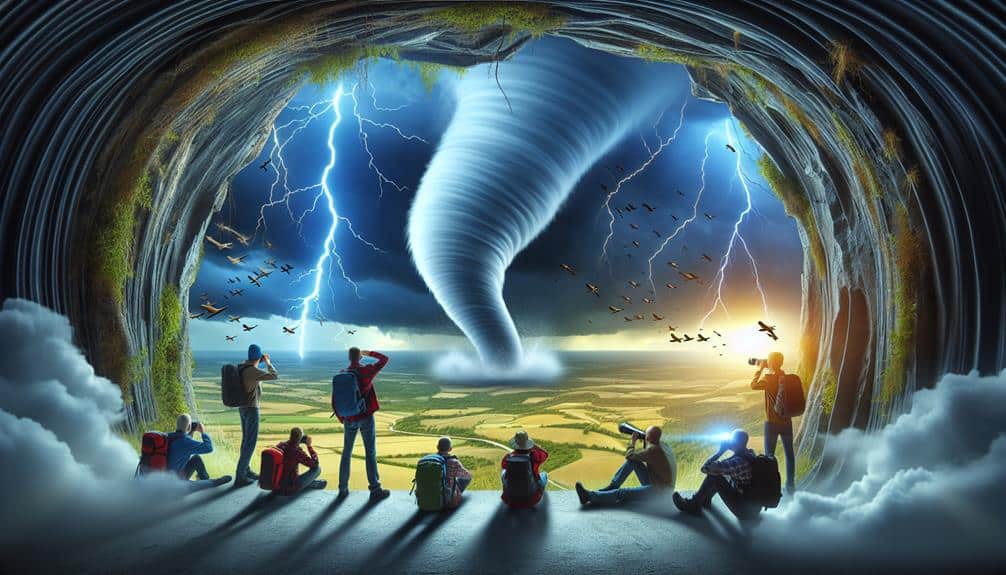
As storm chasers, we must navigate the ethical complexities of our pursuit to guarantee we respect both the environments we enter and the communities we encounter. Our actions can greatly impact public safety and media ethics, and it's crucial we approach storm chasing with a strong ethical framework.
First, we need to prioritize public safety above all else. When we chase storms, our presence can potentially endanger others if not managed correctly. We must make sure our activities don't obstruct emergency responses or put local residents at greater risk.
Second, media ethics play an important role in how we document and share our findings. It's our responsibility to provide accurate, timely information without sensationalizing events for personal gain. Misrepresentation or exaggeration can lead to misinformation, which can endanger lives.
Third, we must respect private property and local laws. Entering restricted areas or trespassing can lead to legal consequences and damage our reputation as responsible storm chasers.
Frequently Asked Questions
What Should I Do if My Vehicle Gets Stuck During a Storm Chase?
If our vehicle gets stuck during a storm chase, we should immediately initiate emergency response procedures and focus on vehicle extraction. Let's use data-driven techniques like winching or traction aids to safely free our vehicle.
Are There Specific First Aid Supplies Recommended for Storm Chasers?
Did you know that 60% of storm chasers encounter minor injuries? We recommend carrying first aid supplies like bandages, antiseptic wipes, and a CPR mask. This guarantees we can act swiftly before the emergency response team arrives.
How Can I Identify Safe Shelter Locations While Chasing Storms?
To identify safe shelter locations while chasing storms, we should analyze weather patterns and terrain data. Prioritize shelter options like sturdy buildings and underground facilities. Utilize GPS and real-time updates to guarantee we're choosing the safest locations.
What Are the Best Clothing Choices for Storm Chasers?
Dressing for storm chasing is like gearing up for battle; we need weather protection and comfortable gear. Choose moisture-wicking fabrics, waterproof jackets, and sturdy boots. Always layer up for temperature changes and pack gloves and hats for added protection.
How Should I Prepare My Vehicle for a Storm Chasing Expedition?
We should guarantee vehicle maintenance is up-to-date, install safety equipment, and have emergency communication tools ready. Regularly check weather updates to adjust our route. This approach maximizes safety and efficiency for our storm chasing adventures.
